Notation
in Elliott Carterís Double Concerto
Robert Strizich
The Double
Concerto for Harpsichord and Piano with Two Chamber Orchestras of 1961 is perhaps the most instructive of Elliott
Carter's recent works to
study from a notational standpoint, since the composer apparently had ample opportunity to hear the piece performed
many times before the score was put in its final form and printed. In fact, Carter has remarked that as a
result of these multiple
hearings prior to publication, he was able to try to make all the indications in the scores "as foolproof as possible")1
The
effectiveness of any notation depends on its ability to convey clearly first to the players, and then in turn
to the listeners, the ideas that the composer had in mind and to which he wanted to give musical
expression. In a work as difficult
and complex as the Double Concerto, the need for notational efficacy is particularly great if the thought
underlying the structure of the work is to be accurately projected and perceived. Thus, it is
interesting to examine the piece from a notational standpoint, in order to test, and hopefully verify,
Carter's assertions of notational
"foolproof"-ness.
The major
aspects of Carter's notation are perhaps best discussed in the context of the basic structural procedure
underlying the entire work - the overlay of separate musical streams. Therefore, the
main part of this paper (Section HO will focus on the notation of these in the Double Concerto, and
will comprise an
investigation of: a) how streams are defined in musical terms, b) how streams are made clear notationally, and c) how tempo fluctuation - an important element in Carter's manipulation
of musical layers - is treated from a notational standpoint. In examining the musical
definition of streams, only the Introduction, Adagio and Coda from the Double Concerto will be considered,
since all of the basic procedures pertaining to stream-overlay are to be
found in these
three sections.
After this
explication, a critical evaluation of the notational procedures in the Double Concerto will be
presented (Section IV), dealing not only with the work's notational strengths and weaknesses, but
also with a particularly controversial aspect of his notation - the notation of non-duple subdivisions.
This evaluation will also
discuss a number of smaller notational details not mentioned in the previous section, drawn from the Allegro
scherzando, the Presto and the Cadenzas, as well as from the three sections already scrutinized
in Section III.
Possible
notational improvements and alternatives will be proposed in Section V, and some observations on
Carter's compositional realization of the basic structural concepts behind the work will be made in
Section VI. Finally, some general conclusions will be
made in Section VII.
However, in
beginning this study of notation in the Double Concerto, it will be helpful to set the stage by examining
briefly the background of the work. The following section will look at Carter's general compositional
preoccupations prior to
the Double Concerto and his specific concerns in writing the Concerto itself, and will also give a brief outline of the work's form.
Background of
the Double Concerto
Elliott
Carter is best known for works of great intricacy and rhythmic complexity, and
his important Double Concerto is one of the best known and most frequently-heard works of this type.
However, the composer's concern with the dimensions of time and rhythm and the simultaneous
occurrence of various layers
or streams of music is something that he has only systematically explored in roughly the past 30 years.
Indeed prior to the 1950s, Carter's works were structured along basically traditional lines, and it was only
during that decade that he
became preoccupied with the more radical and experimental approaches to temporal and rhythmic
organization that have typified his. works in recent years.
In a number
of articles, Carter has discussed the development that h underwent in arriving at his present
musical perspective. He has described h' preoccupation during the fifties as being "a
desire to find a new flow of music thought and
expression - a tendency to which the previous efforts seemed be leading."2
Disregarding the serialistic trends of post-WW II
Europe, which he considered a "return to old-fashioned
avant-gardism" that was not "really 'experimental'
or advanced" with regard to musical time, he instead began to tread his own path
towards "a more significant temporal thought."3
This
interest in the dimension of musical time expressed itself in two different, but complementary, ways. The
first was Carter's interest in "the speeding up and slowing down of themes,"4
that is, the development of musical structures in the temporal sphere by means of tempo manipulation; such procedures were already
at work in the String Quartet No. 1 (1951) and the Variations for Orchestra (1954). The second was what he termed
"a special dimension
of time, that of 'multiple perspective,' in which various contrasting characters are presented simultaneously."5
Such "double and sometimes manifold character simultaneities" led, in Carter's
opinion, to moments of music that were richer in musical expression than had theretofore
been achieved, except, perhaps, in opera.6
Coupled with
these interests in the temporal aspect of music were two additional attitudes towards the
creation of musical materials. One of these has been described by Carter as a "preoccupation
with reduction of musical ideas to their simplest terms";7 it is
this tendency to embody an idea with the most basic material possible that leads, in the Double
Concerto, to a musical thought being consistently represented by merely a single interval, or a length
of time. A second attitude
towards musical material which Carter has emphasized again and again was his concern that the
musical "expression and thought arise from the unique sound and
performance techniques" of the instruments for which he was writing;8
his concern was never that several instruments share the same musical material, but instead that each
instrument play material idiomatically suited to its
particular technique and sonic characteristics.
The gradual
development in the 1950s of Carter's ideas regarding musical time and the shaping of musical
materials gave rise to the creation of the significant body of works for which he is now
noted. The composer's obsession with "multiple perspective" and
idiomatic instrumental writing led quite logically to a repertoire in which each instrument played
different music and in which several musical streams occurred
simultaneously; indeed, the phenomenon of several simultaneous layers of music relating to
one another at times dependently,
at times independently - has been a hallmark of his music since the mid-1950s.
However,
Carter has never been interested in an aleatoric
relationship between
musical streams; in fact, he has specifically repudiated the relating of these streams "in any one of the
possible uncoordinated ways that have been used either by Ives or by others in recent years,- feeling that such procedures produce "a form of entropy, a
degrading of the possibilities of communication."9 Thus, he always has insisted on
notating as exactly as possible the temporal relationships
between layers.
The Double
Concerto itself was a response to a request from harpsichordist Ralph Kirkpatrick for a piece for
harpsichord and piano.10 Carter saw his task as joining compositionally two keyboard
instruments of quite differing characteristics, while
at the same time maintaining their individuality:
The harpsichord and piano in the Concerto . . are each given music
idiomatic to
their instruments, meant to appeal to the imaginations of
their
performers and cast them into clearly identifiable, independent
roles.11
This
concern to create a compositional unity in which the two different instruments could also be given
individual treatment suggested quite naturally the idea of two musical streams, one centered around each of the
two soloists. An ensemble
was then attached to each soloist, which took on the musical characteristics of the solo instrument.
The ensemble associated with the harpsichord (called "Orchestra I") consisted of flute (doubling on
piccolo), horn, trumpet, percussion (two players),
viola and contrabass, while the ensemble associated with the piano
("Orchestra II") comprised oboe, clarinet, bassoon, horn, and percussion
(also two players), violin and 'cello.
Formally the Concerto took
on a symmetrical seven-part form:
Introduction
Cadenza for Harpsichord
Allegro scherzando
Adagio
Presto
Cadenza for Piano
Coda
The Introduction employs all the instruments and introduces the musical material
of the work. The Harpsichord Cadenza introduces material particular to
that instrument, and the following Allegro scherzando
features mainly the piano ant Orchestra II, with occasional
interjections from the harpsichord and Orchestra I.
The central section, the Adagio, develops accelerating and decelerating
material in the percussion, strings and solo instruments against a relatively
static, slow-moving music in the woodwinds and brass. The Presto features
predominantly the harpsichord and its ensemble (with frequent commentary
from Orchestra ID, while in the two piano cadenzas (one actually in the middle
of the Presto, and the other at the end), that solo instrument develops further
its own particular material. Finally, while the Introduction gradually presented
the musical material of the work, the Coda achieves its gradual dissolution;
regarding this cycle of musical formation-dissolution with which the Double
Concerto deals, Carter has mentioned two classical poetic works
which he feels represent literary analogs to his musical
thought - Lucretius's De rerum natura, and Alexander Pope's Dunciad.12
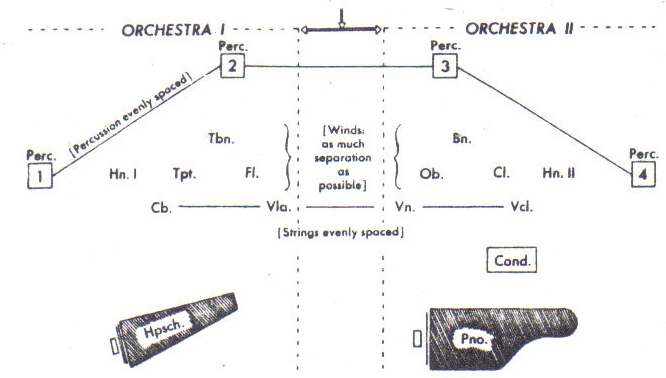
Example 1: There should be as wid a space
between the two orchestras as the stage allows.
The seating plan of the Concerto reflects
its symmetrical form. The two "orchestras" are to be placed
as far apart as the stage allows, with the strings and winds encircled by the
percussionists towards the rear and the soloists in the front. The
percussionists are arranged in a convex arc at the back of the stage
and should be evenly spaced; the strings, placed just in front of the winds and
the first and fourth percussionists, should also be evenly spaced. Thus, the winds
are surrounded by an elliptical ring made up of percussion, strings,harpsichord and piano
(Example 1). The separation between the two orchestras is designed to
bring into audible relief the frequent antiphonal structures in the score,
while the elliptical - almost circular - ring of instruments around the winds
not only symbolically reflects the symmetrical formal plan of the work, but also
gives a circular, swirling shape to the accelerating and decelerating patterns that surround the
slow wind music in the Adagio.
Double Concerto: How Streams Are Defined
Musically In The Introduction, Adagio and Coda
The Introduction deals with ten musical
strands, five of which are assigned to the harpsichord and its
ensemble, and five to the piano and its group. The strands are
introduced one by one at the beginning of the movement, some
dropping out for a time, while others continue. Those that have dropped out reenter
later, and a climactic point is reached about half-way through the movement
at which all ten strands are heard together, converging rhythmically in mm. 45
and 46. A dissolution follows, although after some
antiphonal exchange between the two orchestras, the section again builds
to another high point in mm. 93-99, just before the harpsichord
cadenza takes over in m. 100. Thus, the Introduction
concerns itself basically with the density fluctuation produced by the superimposition of
from one to ten musical strands.
Each strand or stream represents the
articulation of a specific length of time, which is repeated
continuously like a rhythmic "wave." Thus, each strand can
be associated with a metronome speed, the space of time between two clicks
of the imaginary metronome being the time unit pertaining to that particular
strand; the speeds range from 35 (the value of a dotted half-note at = 105, the tempo of the entire
Introduction) to 17.5 (the value of a dotted whole note). Each
time unit is articulated either by continuous sound (Example 2), absence
of sound (Example 3), or by a detailed musical structure (Example 4); the
detailed structures frequently comprise material of a specific density, often expressed by the repetition
of a specific note-value (Example 5).

Example 2: (perc, 2, mm. 7-8)
Example 3: (perc. 3, mm. 8-9)

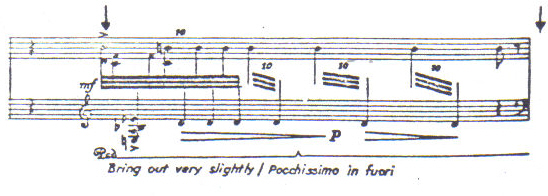
Example 4: (m. 7)†††††††††††††††††††††††††††††††††††††††††††
Example
5: (piano, m.
16, speed 21)
Furthermore,
each speed is associated
with a particular interval; for instance,
in mm. 11-12, the intervals of a minor and major second are heard together,
being identified with the two simultaneous strands with speeds of 24.5 and
25 respectively (Example 6). A chart listing all ten speeds and showing their lengths and
corresponding intervals is to be found in Example 7.
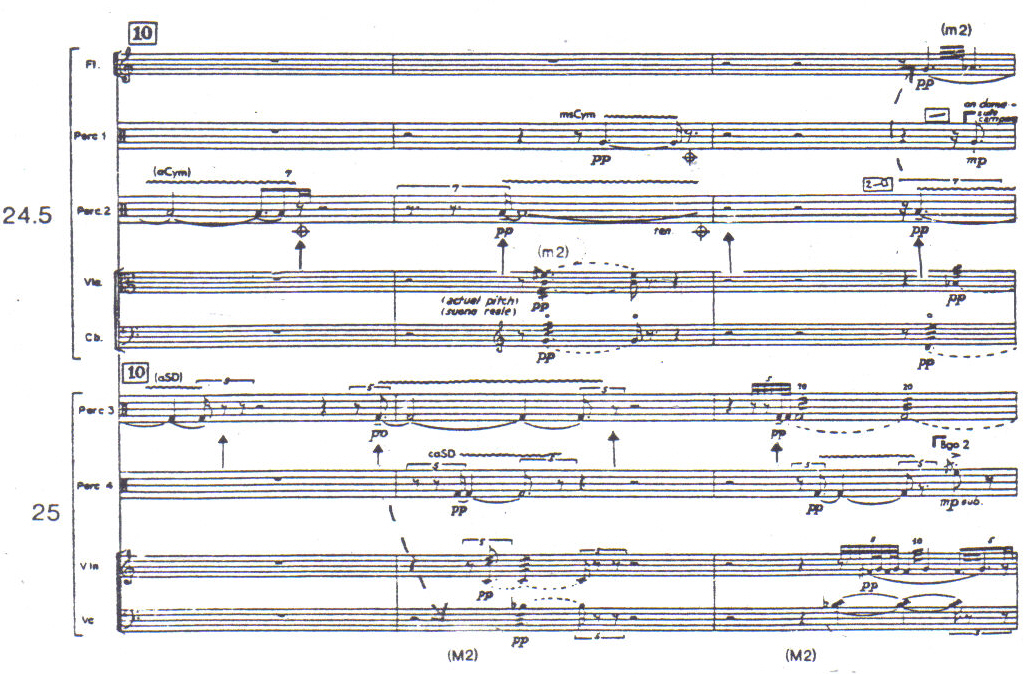
Example 6
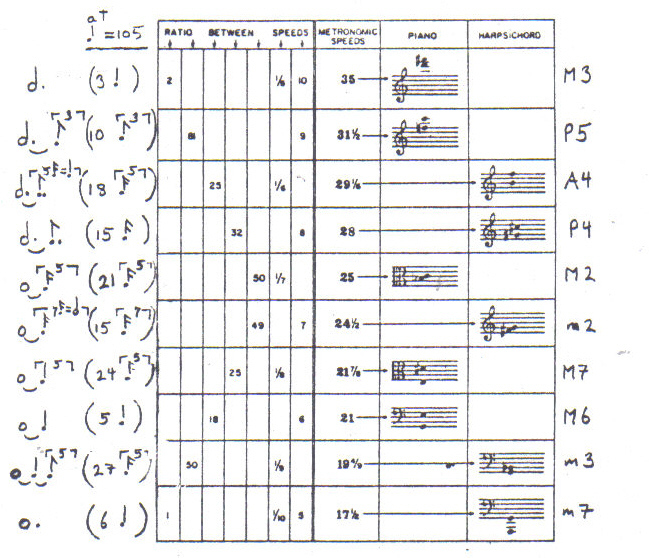
Example 7
Two additional factors are pertinent
regarding the musical definition of streams in the Introduction.
Often, a particular timbre is identified with a stream; for
instance, in mm. 16-17, speed 21 is identified chiefly with the piano, although
there is some additional reinforcement from percussion 4 (Example 8). Also,
changes of texture and/or density often mark the beginning of a rhythmic wave,
as in mm. 37-38, where each "wave" of speed 35 is articulated by a different rate of activity
(Example 9)
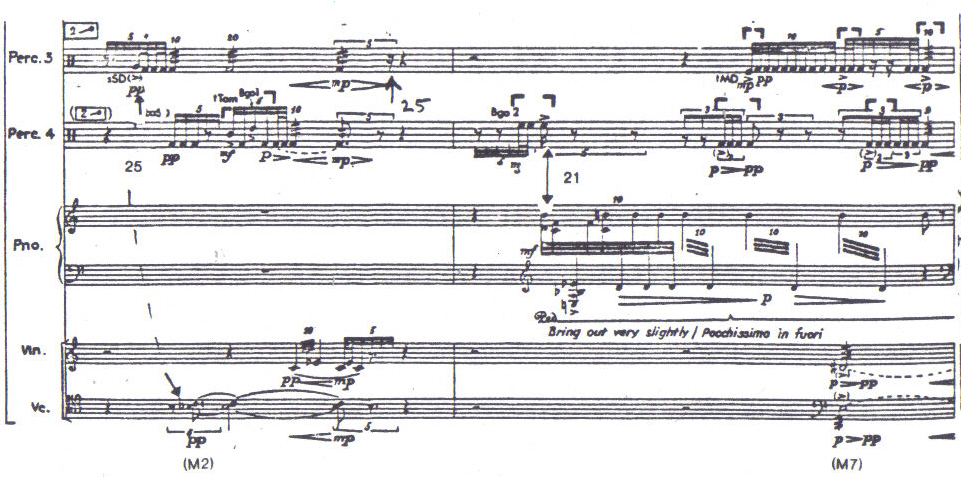

Example 8

Example 9
There are a number of different ways in
which the wave-like structure of the musical streams in the Coda are articulated musically. Often the solo instrument
or the entire "orchestra" will initiate a passage at the beginning of
an accented measure (mm. 620, 624); sometimes the passage will be
preceded by a short upbeat figure (mm. 626). In other instances,
the soloist or the group will build up to an accented beat for
several measures and then cease playing just after the beginning of the
accented measure has been reached (mm. 628, 632). In a
few cases, the soloist or the ensemble again plays a passage building
up to the accented measure, but then ceases suddenly, not actually playing on the accented beat
itself (mm. 640, 652).
Carter seems to treat his basic
structure with more and more freedom as the Coda
progresses: as the end approaches, beats which according to the system
should be accented are frequently left unaccented (mm. 638, 643) or even
empty (m. 648) It is possible that this
increasing freedom is in some way connected with the feeling of gradual dissolution that the composer wishes to project as the work draws
to a
close.
How
Streams Are Defined Notationally
Various notational devices are used by
Carter in the Double Concerto to make the
rhythmic structures in the work clear to both the players and the conductor,
to ensure that the rhythmic structure will be heard by the listener, and to clarify the dynamic and
metric relationships between the streams of music.
The rhythmic
structure of a musical stream is often made clearer for the player
- especially for the soloists - by the direction of the stems; for example,
the upward-turned stem in the harpsichord flourish in m. 18 corresponds exactly with the beginning of the
rhythmic wave of speed 29 1/6 (Example 10).
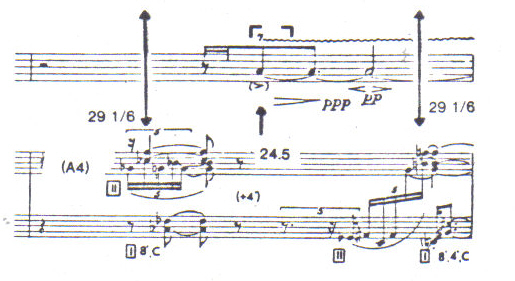
Example 10
In the central movement of the Double Concerto - the Adagio - the musical structure is somewhat simpler than in the
Introduction, as there are basically two simultaneous musical streams;
these two streams are differentiated by virtue of the
relative stasis or mobility of the sound material. The woodwinds and brass play
a relatively slow, static music which comes to a climax about two-thirds
of the way through the movement (at m. 406) and then subsides. Over
this background of relative stasis, the percussion, strings and soloists play accelerating
and decelerating patterns which move in elliptical configurations around
the winds in both clockwise and counter-clockwise motion; there are altogether
six such patterns. Towards the very end of the Adagio, the mobile material
is brought to its own climax (mm. 434-465) which features simultaneous
high-speed passage-work by both solo instruments. In this climactic passage,
the mobile music itself breaks into two separate streams, represented by the contrasting pitch materiai and configurations in the piano and harpsichord.
In fact, the independence of the soloists is
further underscored by two sections of this passage (mm. 434-5 and
453-65) in which the piano actually accelerates independently of the
harpsichord and the remainder of the ensemble.
Still
working with the concept of separate musical streams, the Coda employs yet another method of
juxtaposing two contrasting layers of music. Here, each of the two orchestras articulates a
stream of music, each stream consisting of a regularly recurring pattern of
accentuation in "wave" fashion: the harpsichord group has main accents every fifth
measure with subsidiary accents
every thirty-fifth dotted eighth, while the piano group has main attacks every seventh measure and subsidiary
attacks every thirty-fifth quarter note. Thus, the Coda has largely to do with the
antiphonal interrelationships between the two main ongoing "waves,"
which are at first articulated by a high degree of activity and intensity at the beginning of the Coda
and then gradually subside in activity and dynamic
level as the end of the work approaches.
The
independence of the two opposing musical streams is further underscored by the metrical structure of the
Coda; while the music of the harpsichord group is in 6/8 time, the material of
the piano group is cast in 3/4 time (because of this metrical independence between the two
groups, Carter recommends that two conductors may be used for the Coda). Accompanying these
interrelating waves are long rolls played by all four percussionists, which
seem to proceed somewhat independently of the other
instruments.
In order to clarify the rhythmic structure for the conductor, Carter
occasionally places composite rhythms in the score. In the Adagio, for
example, both the pattern of the accelerating structure in mm. 421-33
and the specific instruments that are articulating this
structure are shown at the bottom of the score on a separate line (Example 11). In the Allegro scherzando, the interrelationship of the opposing musical streams of
Orchestras I and II is
made apparent by the composite rhythm placed in the center of the score (Example 12).
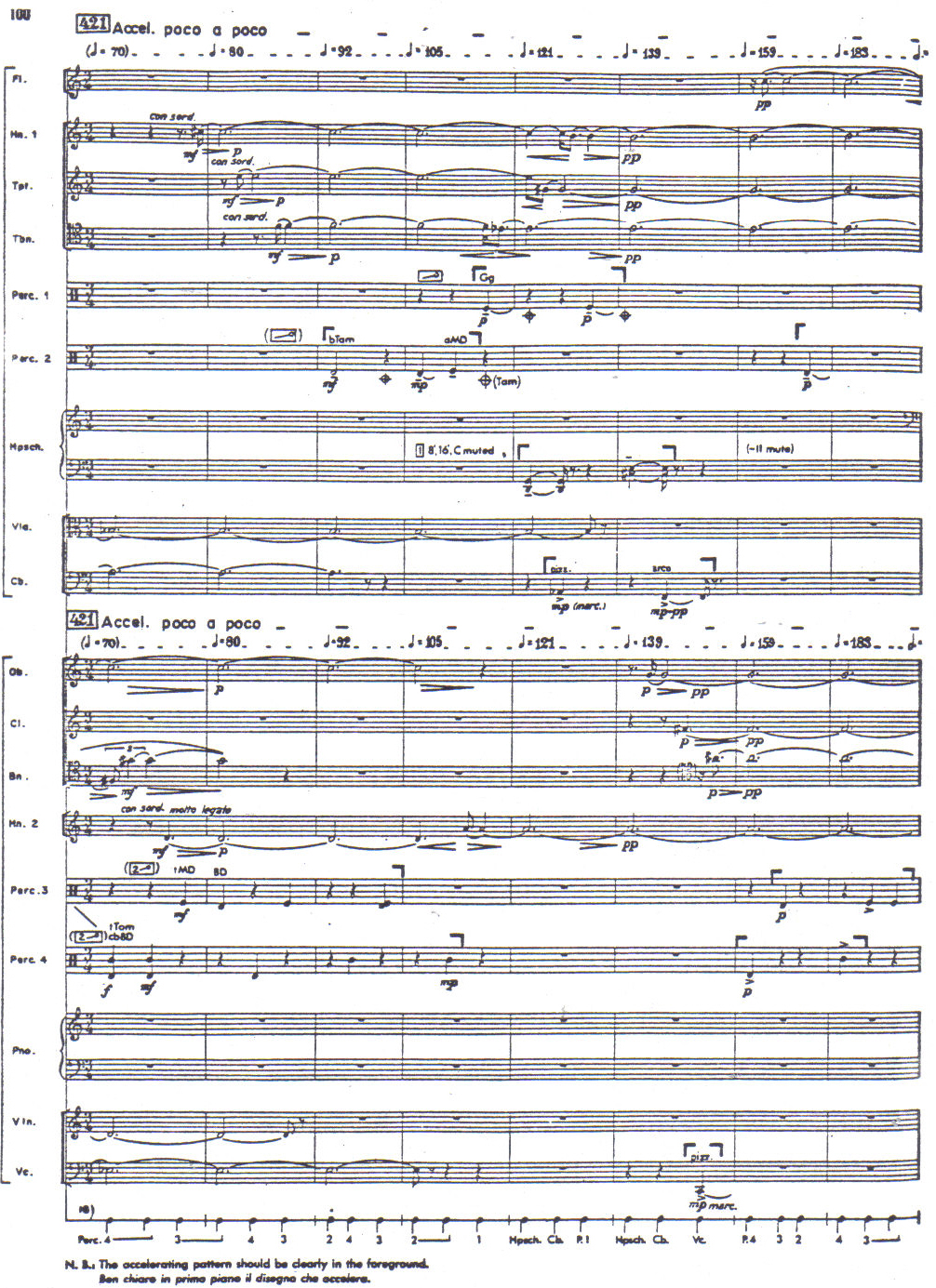
Example 11

Example 12
A number of indications are placed
directly in the music in order to ensure the proper
dynamic articulation of a stream's rhythmic structure. The most common
indications are dynamic markings and accent marks; in mm. 248-50, for
example, notes expressive of the two rhythmic streams (indicated by the composite
rhythms in the center of the score) are marked with accent marks and
are indicated to be played at a higher dynamic level than the surrounding non-structural notes
(Example 12).
Another
indication frequently used by Carter for the same purpose is the bracket
( ). Brackets often mark the note or notes that begin a rhythmic phase,
as in the woodwind and strings parts of mm. 248-50 (Example 12); they also sometimes
enclose not only the note that begins a wave but also the figure forming
an upbeat to it, as is the case in percussion 3, mm. 7-8 (Example 13). Brackets
occasionally designate longer structures delineating a stream; for example,
brackets enclose an entire wave in percussion 2, m. 7 (Example 14), while
in mm. 421-8 of the Adagio brackets enclose every element expressive of the
accelerating structure indicated by the composite rhythm at the bottom of the score (Example 11).

Example 13
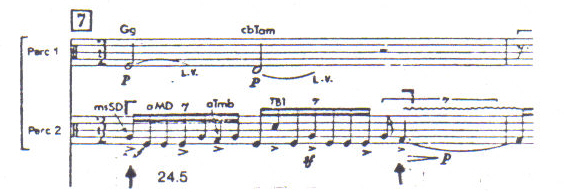
Example 14
Finally, Carter frequently uses verbal
descriptions in the score to clarify characteristics of streams and
interrelationships between them. For example, in order to
regulate the dynamic balance of one of the orchestras, or the balance between
the two solo instruments, Carter indicates verbally which solo instrument
should be in the fore; thus, the piano is indicated as being predominant when
it introduces in the Introduction the speeds 21 in m. 16 and 31.5 in mm. 23-4
(Examples 7 and 15), while the balance between the harpsichord and piano
is controlled by several verbal directions in the brilliant cadenza-like passage
in the Adagio, mm. 434-50. In the latter case, the verbal directions indicate
whether the piano should be slightly louder than, or evenly balanced with, the harpsichord.
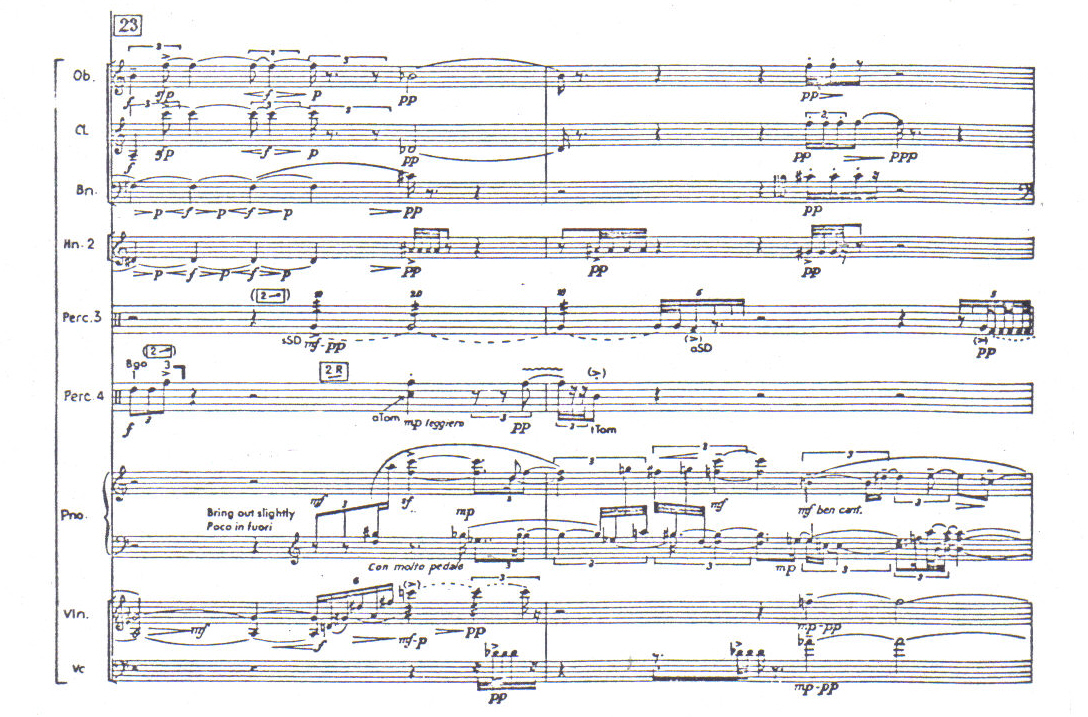
Example 15
In addition to regulating dynamic
balance, verbal indications also clarify metric
interrelationships between the musical streams. In the Adagio, the contrast
between the mobile material characterized by tempo fluctuation and the more static slow music in
the winds is underscored at one point by Carter's prescription at the foot of
page 100 of the score that "the accelerating pattern should
be clearly in the foreground." Further on in the same movement, verbal
directions on pages 102 and 108 make it clear that at these points the piano is
to
accelerate independently of the rest of the ensemble.
How Tempo Fluctuations
are Handled Notationally
Carter makes use of two methods of
notating tempo fluctuation in the Double Concerto: metric
modulation and very precisely notated accelerandos
and ritardandos.
While the former method is found in several sections (the solo cadenzas,
the Allegro scherzando and the Presto), the latter is
found chiefly in the central Adagio.
Metric modulation is a method of
handling tempo fluctuation that Carter has used in many of
his works since the 1950s. It is, in essence, a simple procedure
that has three basic steps. First, a specific tempo or pulse is established.
Then a new rhythmic figure is introduced that moves at a speed either faster
or slower than the speed already established. Finally, this new figure then
becomes the basis of a new pulse or tempo. A clear example of metric modulation
can be seen in Example 16, taken from mm. 109-114 of the harpsichord
cadenza; here, in the space of a few measures, the tempo fluctuates three
times, from
q = 98 to
q= 56 to q = 70. The first tempo,
q
= 98, is clearly
established by means of the continual
eighth-note
motion in the left
hand. Then in m.
110 a new pulse is introduced in the right hand, expressed by "beats" equal to seven
sixteenth-notes at the established tempo. Then in m.
111, these new beats become equal to one
quarter-note of the new tempo, q = 58. In m. 112, quintuplet sixteenth-notes are
introduced, which then are interpreted in m. 113 as regular sixteenth-notes, thus establishing the third
tempo,
q= 70.
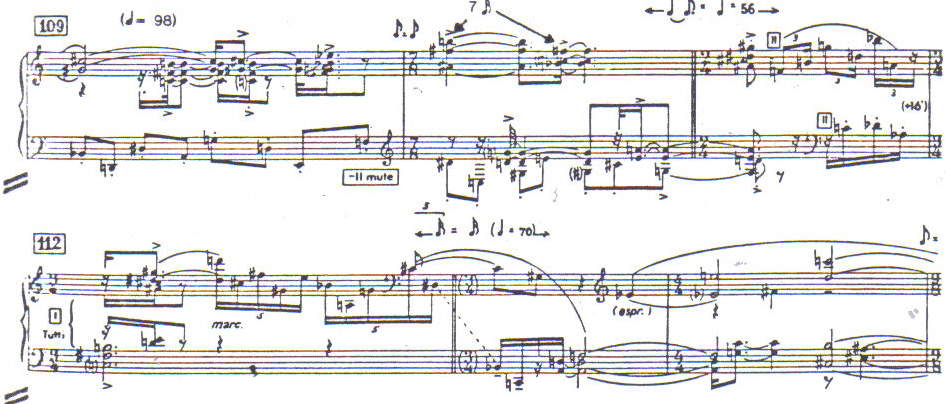
Example
16
In both the
harpsichord and piano cadenzas, the music undergoes many such metric modulations. In the Allegro scherzando, there are altogether six tempo fluctuations handled by this
procedure, while in the Presto, metric modulation is responsible for three
tempo fluctuations before the first piano cadenza and
for two tempo fluctuations after the second piano cadenza.
The second
method for handling tempo fluctuation - found only in the Adagio - involves the precise notation of
accelerating and decelerating patterns. There are altogether five such patterns in this section. Although
the accelerandos and ritardandos
are actually notated for the entire ensemble, the tempo fluctuations are heard only in the most
active instruments - the soloists, percussion and strings - while the slower-moving instruments (the winds)
sound as if they are playing a static background.
Carter perhaps
could have chosen to notate these gradual fluctuations in the usual way, indicating that the
music should increase in speed gradually by means of an "accelerando" marking.
Instead, he has chosen to indicate an exact tempo-marking for every measure of the pattern, each measure
having a slightly faster
tempo indication than the previous one. This method has the disadvantage of seeming overly
picayune, but has at the same time the advantage of indicating the exact rate of speed at
which the accelerando is to proceed.
For
example, between mm. 421 and 434, the music accelerates from quarter-note
motion at = 70 to eighth-note triplet motion at = 140. Carter does indicate this gradual increase in
speed by writing "Accel. poco a poco" at m. 421 and extending a broken line up
to m. 434. However, underneath this general indication is a much more precise one which proceeds as follows.
The speed of the
quarter-note motion (beginning at q =
70) is brought up to just under the speed
of eighth-note triplets at .1
70 in mm. 421-428 by
giving each of the eight
measures a slightly faster tempo marking (q
= 70,
80, 92, 105, 121, 139,
159, 183). Then at m. 429, the eighth-note triplet motion at q
= 70 takes over, still accelerating up to m. 434, each of the measures
in this part of the pattern being also given
gradually increasing tempo markings q
= 70, 80, 92, 105, 122, 140). By means of this graphically
complicated procedure, the effect of a gradual increase in
speed in the instruments playing the "mobile" music
is achieved. The addition of the composite rhythm at the bottom of the score
(already illustrated in Example 11) makes the intent of this accelerating structure quite clear.
A Critical Evaluation of Carterís Notation in the Double Concerto
Strengths
In
much post-World War II music, a great deal (perhaps too much at times?)
frequently has been left up to the executant,
with the result that performers have often become confused regarding the
intent of some new music, exasperated by the ambiguities it presents, and, as a
result, hostile to many recent compositional developments. Given this context,
it can be seen as a
strong
point of his work that Carter has taken such pains to convey his ideas as exactly as possible to
the performer. Indeed, even the brief foregoing discussion of the
notation in the Double Concerto should make it apparent that his notation is highly
detailed, meticulous and fastidious. A number of additional notational
factors - not previously mentioned because they had no direct bearing on
the notation of separate musical streams - are present in the Double Concerto which reinforce the above
impression even further.
For instance, at the very
beginning of the work, Carter gives a clear explanation of his method of notating non-duple subdivisions
the first time they occur; in mm. 3-4 he
indicates in percussion 2 and 3 that a sixteenth-note septuplet equals a half-note, and that a
sixteenth-note quintuplet equals a quarter note (Examples 17aand b), Also at
the beginning ay a curved dotted line with an arrow (
 ) indicates that a
written-out
ritardando is occurring in mm. 2-3 of
percussion 2 and an accelerando in mm. 2-4 of percussion 3 (Examples 18 a & b).
) indicates that a
written-out
ritardando is occurring in mm. 2-3 of
percussion 2 and an accelerando in mm. 2-4 of percussion 3 (Examples 18 a & b).
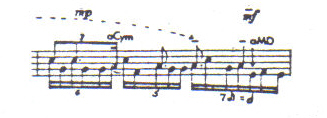

Example 17a: (perc. 2, m.
3)†††††††††††††††††††††
Example
17b: (perc. 3, m. 4)

Example
18a: (perc, 1 & 2. mm. 2-3)

Example
18b: (perc. 3, mm. 2-4)
Carter also beams fast notes according
to metric placement (e.g., beat-by-beat) - rather than according to musical
organization or phrasing - in order to make reading
easier. At several points in the work, overall dynamic patterns (that
might otherwise not be apparent) are indicated by verbal description or wedge
signs in the middle of the score. At one point in the second piano cadenza, short vertical
arrows are inserted over the
staves to indicate the presence of several equal pulses that are to
be heard over a metric modulation (Example 19).

Example
19
Finally, two more examples of Carter's meticulous
notation are to be found
in the last two sections. Towards the end of the Presto in mm. 608-11,
composite accents applying to both orchestras are indicated in the appropriate instrumental parts by means of short vertical arrows. In the
Coda, the sign * is placed over the score at a number of points,
indicating that at those instants the entire ensemble must perform
their decrescendos just enough to allow the harpsichord to be heard.
Weaknesses
In spite, however, of the commendability of Carter's effort to make his notation
as explicit as possible, the notation in the Double Concerto presents a great number of rather
serious inadequacies.
One fault may be the fastidiousness
itself; the proliferation of meticulous detail requires so much of the
performer from the standpoint of technique and expression, that
the demands may be overwhelming. Very often, the requirements
of the notation are so explicit as to seem overly fussy and even unreasonable;
for example, in the Introduction (whose tempo is
q = 105), Carter several times
requires the players to subdivide a quarter note into exactly ten parts,
rather than prescribing an unmeasured roll or tremolo - which would, of course,
be the aural effect of his overly-explicit notation anyway (Examples 20 a
& b). It is for such over-exactitude that he has been justifiably
criticized by Gardner
Read:
The Double Concerto, the Piano Concerto, the Concerto
for
Orchestra,
and all three string quartets bring to mind
Schoenberg's remark -
applied to his own music - that such
music must be realized with
"inexorable severity." The players of
Carter's works cannot "interpret" the
music; they can only follow as best they can his minutely
conceived
and rapidly fluctuating indicia. The scores, as they stand,
vividly
illustrate the pitfall into which the over-zealous notator
can tumble: their hyper-exactitude
becomes more inhibiting than the most calculated obscurity.13


Example 20a: (perc.
3, m. 16)
Example
20b:
(m. 12)
Furthermore,
there are many details of Carter's notation which are confusing, unclear, or contradictory.
Particularly disturbing is Carter's frequent use of brackets ( ) in confusing and redundant ways, in
which the applicability of their
defined meaning ("principle voice") is dubious. For instance, there
are a number of places in
the Coda where one quarter-note or eighth-note out of a long percussion roll is bracketed, in
spite of the fact that the piano (and often other instruments as well) is playing at a higher
dynamic level than the percussion in question (Example 21); in fact, in one
such passage, Carter has expliditly indicated
"Piano and Harpsichord to the fore" (Example 22). In other instances in the Coda, occasional notes
in the harpsichord part are bracketed, without any apparent reason for these few notes to
be more important than others
in the surrounding texture (example 23). Such usage of the brackets not only
contradicts the definition of their given meaning, but also taxes the patience of the reader of the score.
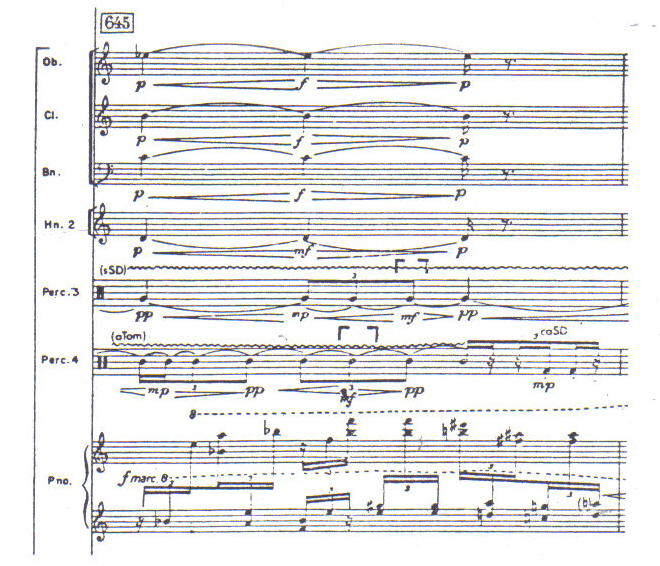
Example
21
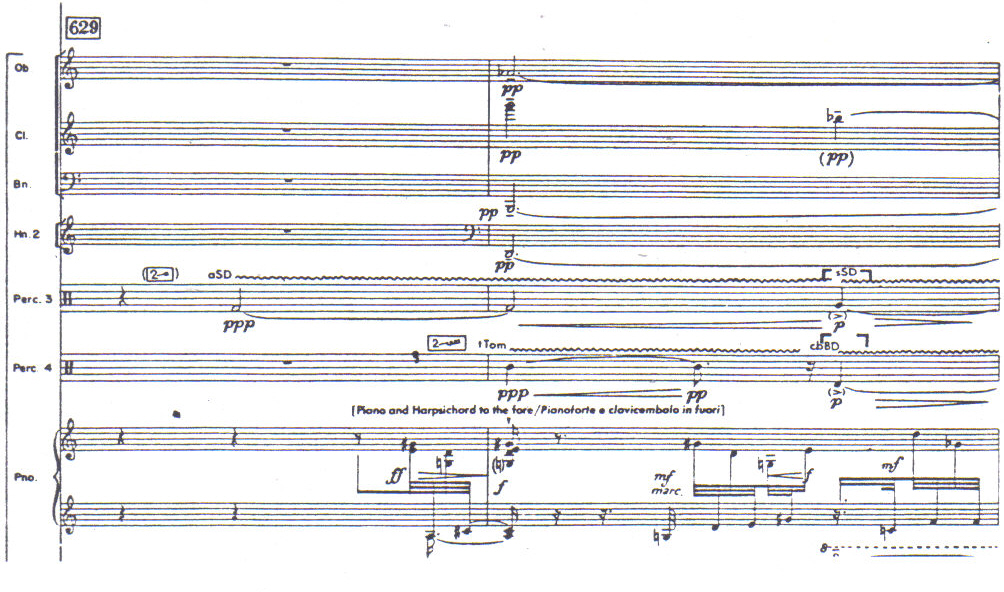
Example
22

Example
23
In several places, Carter's verbal instructions also unclear. A
case in point
is the 12-measure passage in the Adagio (mm. 452-65) in which the piano gradually
accelerates while the remainder of the ensemble gradually decelerates;
showing a surprising lack of his usual fastidiousness, Carter does not
indicate at what speed the piano accelerando should terminate, at what rate the
accelerando should proceed, or whether the indicated alignment between the
piano and the rest of the ensemble in the score should be adhered to. Another
unclear verbal description is the composer's comment that a passage in the
second piano cadenza should be played "very precisely and as one line (not
two);" a glance at this passage (Example 24) will show that due to The rhythmic and aarticulative
independence of both hands, it is very difficult to understand how the pianist could
render these two lines as one.
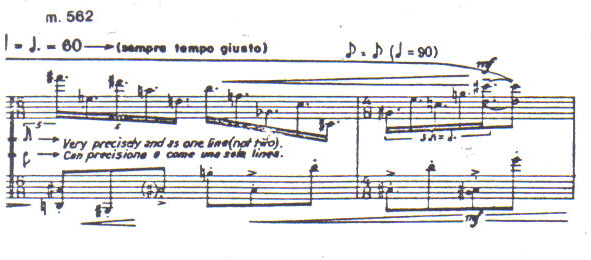
Example 24
Also puzzling is Carter's contradictory use of short vertical
arrows; whereas these are
used to indicate equal beats over a metric modulation in the second piano cadenza (mm. 558-60), the same symbol is
used at the very end of
the Presto (mm. 608-11) to indicate simultaneous accents in both orchestras. While there is perhaps little danger of confusing the
separate meanings of this symbol - due to the fact that it occurs the first
time in a solo cadenza and the second
time in a tutti passage
- it nevertheless might have been better from the notational standpoint to have used two separate
symbols.
Another
possible weakness of Carter's notation is his insistence on metric beaming; while this type of notation has the advantage
of giving the player a beat-by-beat
picture of the music, it has the disadvantage of not effectively indicating the real rhythmic groupings of notes. Kurt Stone
has commented on this problem,
and has proposed two stages of modification for Carter's notation, each of which would make the musical intent clearer. he has taken a measure from the Introduction (Example 25a), in which typical
examples of Carter's metric
beaming are to be seen, especially in the flute and percussion 2. In his first re-written version, Stone proposes that the beams
covering entire beats
could be removed, resulting in a visually clearer picture of the rhythmic groupings (Example 25b). In his second proposed version,
Stone has gone further and
beamed the groups of notes according to their rhythmic grouping, in spite of the fact that this involved beaming across beats
(Example 25c). This latter method
certainly has the advantage of making the rhythmic groupings as clear as
possible, but might make reading of such passages more difficult; indeed it seems as if Stone's first proposal best balanced the
factors of legibility and graphic depiction of
musical intent.14
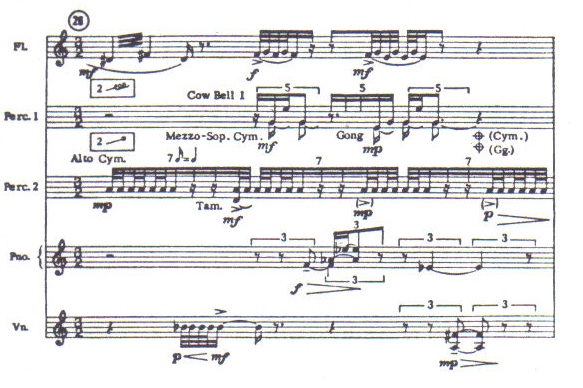
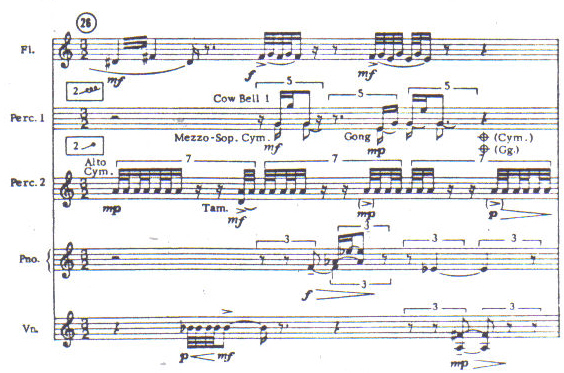
Example 25a†††††††††††††††††††††††††††††††††††††††††††††††††††††††††††††††††††††††
Example 25b

Example 25c
Perhaps the most serious fault of
Carter's notation in the Double Concerto, however, is that
the notation does not depict the various musical streams in a simple,
visually clear manner, nor does it convey to the players to which stream they
belong and how their contribution fits into the overall context. This problem
is certainly present in the score, for it takes a great deal of reading of the
composer's own comments, combined with detailed study of the music, before the
conductor, student, or listener can perceive the underlying structure of the work.
Matters are not any clearer in the individual parts either; aside from the usual
cues, the parts are basically a reproduction of the individual lines from the
score, and do not give the player any idea of how his line fits into the
overall structure.15
Kurt Stone has also commented on this problem, taking as an example a passage
from Carter's String Quartet No. 2, whose visual complexity, though considerable,
does not rival that of the Double Concerto (Example 26a). Stone then
goes on to show how each of the individual lines in the passage could be notated
in a far simpler, more visually direct manner, were it not for the problem that all four lines must
be coordinated (Examples 26 b, c & W.16
Unfortunately, such vexing notational dilemmas are
perhaps unavoidable to some extent, given the style of
notation and the medium of expression with which Carter has chosen
to work. Indeed, this problem is, at least in part, the inevitable result of using
traditional notation and uniform tempo control for an entire instrumental ensemble.
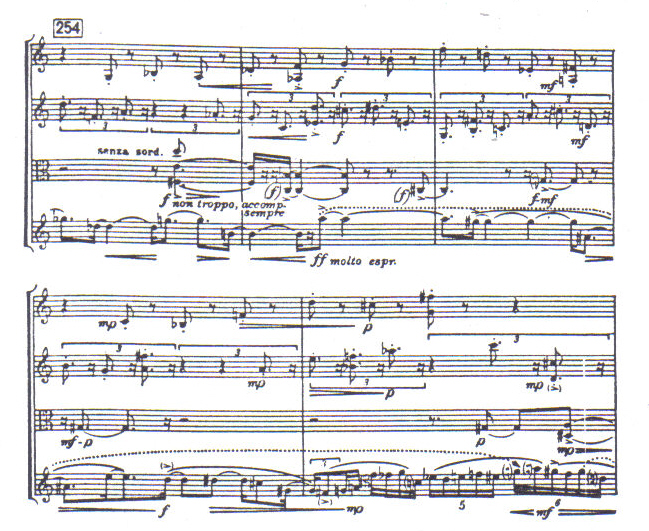
Example
26a
Example 26b: (yin. II)
Example
26c: (via.)

Example 26d: (cello)
A
Controversial Aspect of the Double Concerto: The
Notation of Non-Rational Subdivisions
One aspect
of Carter's notation in the Double Concerto that has excited considerable controversy is his notation
of quintuplet and septuplet subdivisions of beats - often termed non-duple, "artificial" or
"irrational" subdivisions. Carter himself has alluded to the controversial nature of his notation of
such subdivisions:
In it [i.e., the Double Concerto] there are many problems of
notation -
the awkward dotted notations, used for quintuplets and
septuplets in
compound time, that have bothered performers in Warsaw and
elsewhere. In defense of them, I do not think many passages which use
dotted
and undotted notes simultaneously could have been
notated as
clearly.17
The issue
concerns two aspects of the notation of non-duple subdivisions - their notation in simple meters and
compound meters. In simple
meters, Carter has subdivided quarter notes into five sixteenth-notes when writing quintuplets, a practice which has met
with no disagreement: however, in writing septuplets against a half-note, he has chosen to use
sixteenth-notes instead of
the more usual eighths. In compound meters, Carter subdivides a dotted quarter-note into five dotted
sixteenth-notes when writing quintuplet figures, rather than using five undotted eighth-notes, which is the more usual practice.
He has
explained that he based his practice on the system propounded by Renée Longy-Miquelle
in a text dating from the early part of the century, the Principles of Musical Theory (Boston, 1925).18 He defends
his dotting of irrational subdivisions in compound meters by pointing out that
when dotted, they are immediately distinguishable from
irrational subdivisions in simple meters:
The question of the notation of artificial divisions of dotted units has
even less uniform agreement. It seems to me that Mme. Miquelle's
method, cumbersome as it looks, has the advantage (in music that is in
alternations
of 6/8 and 3/4) of making the different groups of artificial
divisions look different
at once.19
A strong
position against Carter's method has been taken by Gardner Read. Arguing in favor of Hindemith's
method of writing non-duple subdivisions in simple
meters, he states:
it is not possible, however, to go along with Carter
in advocating the method
of notation for artificial divisions expounded in an outmoded text by Renée Longy-Miquelle.
This system uses identical note-values when writing quintuplets and sextuplets against
duplets or quadruplets. But
the next smaller note-value is employed for septuplets.The author's reasoning - to me, completely fallacious - is that seven is closer to
eight than to four (the first division of a quadruplet); therefore, one should
use the note-value that would
be employed for eighth-notes as the unit. Far more accurate in the mathematical sense, and more
generally applied by composers today, is the principle advocated by Paul Hindemith. He would retain the same note-value for both the regular
and the extraordinary groups until the notes in the irregular group exceed twice
the value of the normal
group. This is only another way of saying that the note-value in the extraordinary group does not change
until the number of notes contained therein enters the
second division of the basic unit.20
Thus, Read
would advocate the use of eighth-notes (rather than sixteenth-notes) for writing a septuplet against
a half-note, since seven does not yet exceed twice the
normal number of eighths for the unit.
Read is
not in disagreement with the practice of subdividing a dotted quarter-note in compound time into five
or seven sixteenth-notes when writing quintuplets or septuplets. He is, however, strongly opposed to Carter's
practice of dotting
quintuplet and septuplet sixteenth-notes in compound meters, since the traditional meaning of the augmentation dot is thereby negated:
The patent illogicality
of dotting each note (or rest symbol) within a quintuplet or septuplet, in
either simple or compound time, is not a
matter of personal taste and discretion but of simple mathematics. Whereas duplets and quadruplets can, and
even should, consist of
dotted notes in compound time, all other irrational figures cannot. If the augmentation dot still means what it always has since its
invention in
the seventeenth century - the increase by one-half of the note value it follows - it cannot be
applied to rhythmic
figures whose total
value would
then exceed, or fall short of,
the normal number of units
within
the prevailing pulse
or
measure.21
in
the seventeenth century - the increase by one-half of the note value it follows - it cannot be
applied to rhythmic
figures whose total
value would
then exceed, or fall short of,
the normal number of units
within
the prevailing pulse
or
measure.21
Especially when consulting a visual
comparison between Carter's method of the notation of irrational
subdivisions and Read's counterproposals (Example 27),
one cannot help but side with Read, particularly where the matter of non-duple
subdivisions in compound meters is concerned. The use of the augmentation
dots is not only mathematically incorrect, but also gives a needlessly over-complete
appearance to the eye. Indeed, one must further agree with Read that such practices
are an unnecessary hazard for the
conductor and performer, already burdened by rhythmic complexities
and defy easy solution. In his zeal for meticulous
notation the composer has perhaps become overly complicated, rather than clear and
unequivocal.22
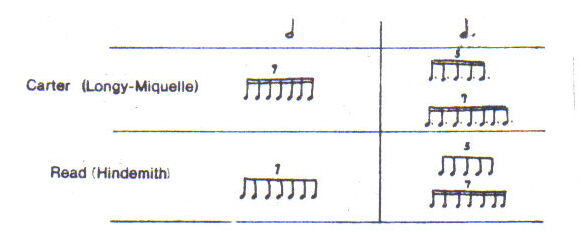
Example 27
Some Possible Notational Improvements and Alternatives
Improvements
In view of the notational difficulties
mentioned above, it seems appropriate to suggest some possible improvements to
Carter's notation in the Double Concerto.
The most obvious suggestion would call
for a rectification of confusing, unclear or contradictory
elements. In particular, unmeasured rolls or tremolos could be substituted for
the over-fastidious fast subdivisions of quarter-notes, and
the extremely confusing over-use of brackets could be eschewed. Also, some
degree of rhythmic beaming - similar to that proposed
by Stone in Example 25b - might make the musical intent clearer in many cases.
Furthermore,
there are several improvements that might provide more assistance to the player and conductor in
recognizing how musical streams are defined and related. For instance, more verbal explanations and/or
composite rhythms might make the rhythmic structure more apparent. It is also
thinkable that the
placement of some simple symbol (perhaps an "x") over the score at the appropriate points might be a
practical way of marking the location of pulses pertaining to each stream. Finally, some
manner of showing the individual player to which stream he belongs would be especially helpful in
making it clear how his line fits in to the overall context; such indications could take the form of cues, verbal statements, dotted lines in the score, numbering
for each individual stream, etc.
Alternatives
In addition
to the above suggestions for improvement, it is possible to envision several
proposals for notational alternatives, although some of these either might involve styles of notation to
which Carter would not ascribe, or might not be as effective in musical situations as
complicated as those found in the Double
Concerto.
In any case,
one could imagine transcribing at least some portions of the work into proportional notation, using
a general conductor's beat to coordinate the entire ensemble. Such a solution would
certainly contribute greatly to visual clarity of the parts and ease of playing; it
would, however, have the disadvantage that at least some rhythmic ideas could not be conveyed with as
much exactitude, and not nearly as much ensemble
precision would be possible.
Another
possibility would be actually to notate the various musical streams in different tempi, to notate the score
traditionally and bar each line according to the natural pattern of recurring
accents found in each stream, to lay out the lines in the proper proportional relationship to
one another, and then to have the various streams conducted by several conductors. In this way, rhythmic
ideas could be conveyed as
exactly as they are in the present score, with the added advantage of increased visual clarity,
since the actual metrical structure of each line would be readily apparent. Still, it is
uncertain whether the precision of coordination desired by Carter would be possible, unless the conductors
had an extremely precise sense of tempo.
Emmanuel Ghent has actually made a
proposal for a renotation of the Double Concerto
much along the lines of the second of the above suggestions, also making
use of his method of electronic cueing. He has renotated
a short passage from the Introduction (mm. 12-16) with
proportional spacing, using only the four percussion lines for
purposes of clarity (Example 28a); a second version (Example 28b) renotates the lines in four different tempi, each line barred according to its individual metrical structure, with
an "x" over the staff marking the location of each pulse
pertaining to any given musical stream. The players would wear
earphones, and would be cued electronically just before
each necessary
tempo change.23


Examples 28 a
and b
This method certainly has the
theoretical capabi!ity of dealing with
11 work as complex as the Double Concerto. However, the
music would have to be written with electronic cueing in mind,
since the players need some time to assimilate the cue
for a new tempo before any tempo change. The feasibility of this method
as a viable and workable alternative to the present notation of such a work would have to be
carefully tested in practical trials.
Observations
on the Compositional Realization of
the Basic Structural Concepts in the Double
Concerto
Aside from the numerous notational
difficulties in the Double Concerto, there seem to
be additional problems involved with Carter's realization of his basic
compositional ideas which tend to obscure the musical structure for the listener.
For instance, Carter's presentation of
the overlapping musical strands in the Introduction often seem
purposely ambiguous, as can be seen by comparing the basic
rhythmic plan of the opening of the movement (Example 29) with the score itself. For
instance, the entry of the first strand in m. 6 does not seem sufficiently set apart from
the previous introductory material to enable the listener to
detect the beginning of a new structure (Example 30). Then, instead of leaving
(in percussion 3) a clear space between the second pulse of the first strand
in m. 7 and the upbeat figure to the third pulse in m. 8, Carter immediately
confuses the matter by the insertion of an additional role in percussion 4 (Example 31).
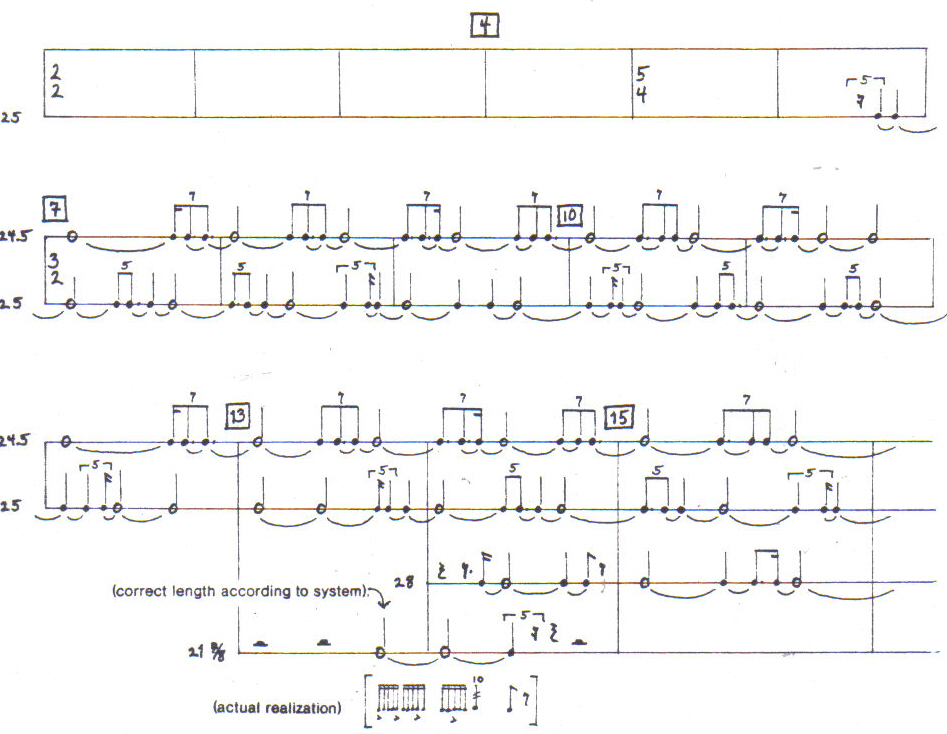
Example 29

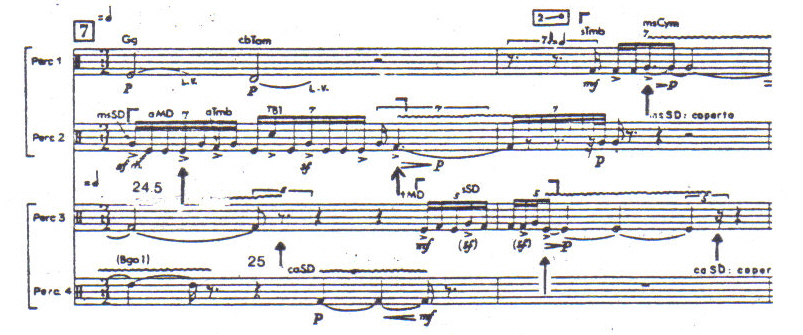
Example 31
Notice also that the numerous accented
notes in the quintuplet and septuplet upbeat figure in mm. 6-8 are
just as strong as the note that mark the beginning of each
"wave," thus making it almost impossible for the listener to hear which
of these many accents is structural; furthermore, given the speed of the upbeat
figures (especially those in quintuplets), it is difficult for the listener to perceive a difference
between anticipatory upbeats and rolls.
Also, it will be seen that the two
bracketed notes in percussion 4 at the end of m. 12 and the
beginning of m. 13 confuse the audibility of the two musical streams
at that point; while the second note at the beginning of m. 13 does fall at
the beginning of a "wave," it is overshadowed by the previous note -
marked with an accent and a louder dynamic level - which does not
coincide with a structural accent at all (Example 32).

Example 33
Finally, the third musical stream (speed
21 7/8) is not fully expressed when
it enters in mm. 13-14; although its characteristic interval (a major
seventh) is present here and returns several times in subsequent measures, this
one inaccurate statement is all the listener is given until much
later in the section (Example 33).
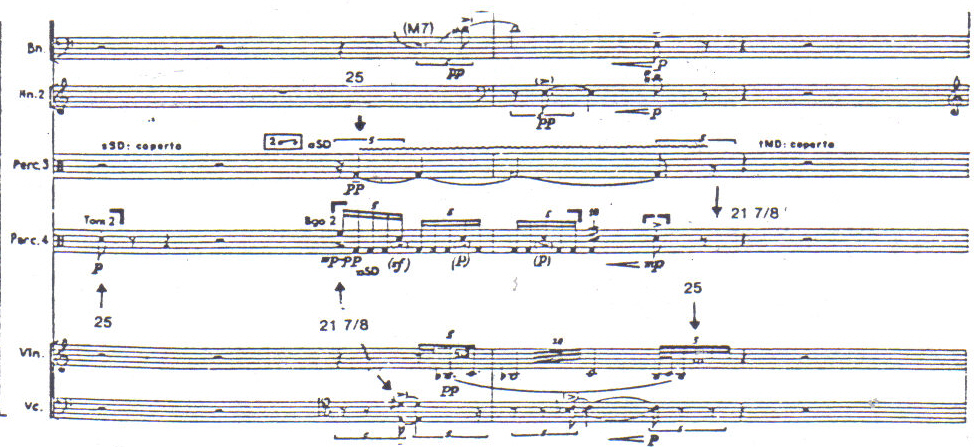
These
departures from, and obfuscations of, the structural system of the Introduction are only a few of the
myriad liberties taken in the compositional realization of the structure in this and other
sections. Indeed, one wonders not only why the realization of the underlying
musical and rhythmic structure is not more clear and emphatic, but also whether Carter actually intends the
structure of the work to be
understood by the performers or perceived by the listeners. Is the basic structural framework - which
he emphasizes again and again in his writings - not meant to be heard as such,
and instead intended to serve as a means to some other
musical end that he has not mentioned?
In any case,
if one takes the point of view that the structure must be audible for the work to be understood, it
is tempting to imagine that the comprehensibility of the Double Concerto could be
greatly improved if certain changes were made in the compositional realization. For example, dynamic
suppression of
non-structural notes would greatly facilitate the listener's ability to
perceive the rhythmic organization of the work;
possibly a visual distinction between ornamental/non-structural
notes (different colors, size, etc.) and structural ones could be of considerable help to the player in
this regard. Even more helpful to both
player and listener might be the actual removal of many non-structural notes and figures; indeed, greater clarity of
texture could lead to much greater structural audibility.
Conclusion
There is
little doubt that Elliott Carter's inventiveness, integrity and discipline are impressive, and that his
musical concepts are strong, provocative, and rich in possibilities. His compositional
realization of these concepts is highly elaborate, and
his notation is exacting, meticulous and even painstaking.
Yet it is
precisely the great intricacy of the realization that paradoxically tends to obscure the clear projection
of much of the work's musical thought. The implosive force of the notational and
compositional detail not only weighs the piece down, but
also strains the abilities of both player and listener alike.
Thus, while
the Double Concerto opens new vistas and explores exciting musical territory, it at the same time
raises serious questions regarding the realization, notation, projection and comprehension
of highly complex musical ideas.
Bibliography
Carter, Elliott. Program
note for the "Epic" recording (LC 3830) of the Double Concerto (no date); Ralph Kirkpatrick, harpsichord, Charles Rosen, piano, Gustav Meier, conductor.
__ . Letter in "Letters to the Editor," Journal of Music
Theory, Vol. 9, No. I
(1965), pp. 270-273.
__ .
"The Time Dimension in Music" in Kurt Stone (editor), The Writings
of Elliott Carter (1977), pp. 246-247.
___ †"The Orchestral Composer's Point of
View" in Stone, op. cit., pp. 290-298.
__ . "Double Concerto for Harpsichord and Piano
with Two Chamber Orchestras (1961),
Duo for Violin and Piano (1974)" in Stone, op. cit., pp.
326-330.
________ . "Music and the Time Screen" in Stone, op.
cit., pp. 350-357.
Ghent, Emmanuel. "Programmed Signals to Performers: A New Compositional Resource" in B. Boretz and E.T. Cone (editors), Perspectives on Notation and Performance (1976), pp. 134-144.
Read, Gardner. "Some Problems of Rhythmic Notation" in Journal
of Music
Theory, Vol.
9 (1965), pp. 153-162.
______ . Modern Rhythmic Notation (1978),
pp. 46-49.
Stone, Kurt. "Problems
and Methods of Notation" in B. Boretz and E.T. Cone (editors), Perspectives on Notation and
Performance (1976), pp. 14-15,
18-26.
1
Kurt Stone (ed.),
The Writings of Elliott Carter (1977) p.
296
2 Stone,
op. cit., p. 351.
3 ibid., p. 351.
4 ibid., p. 246
5 ibid., p. 355.
6 ibid. p.
356.
7
ibid.,
p. 350.
8 Stone,
op. cit., p. 326.
9
ibid., pp. 353 and 355
10
ibid., p. 326.
11
ibid.. p. 328.
12 Stone, op. cit.,
pp. 296 and
329.
13 Gardner Read, Modern
Rhythmic Notation (1978), pp. 48-49.
14
Cf. Kurt Stone, :Problems and Methods of Notation," pp. 23-5 in B. Boretz and
E.T. Cone) eds.) Perspectives on Notation and Performaonce (1978)
15 The
parts fcr vo n and
percussion 1 were examined for
this study.
16
Kurt
Stone.
op. cit. (in footnote 14), pp. 1 8-1 9.
17 Stone, The
Writings of Elliott Carter (1977), p. 296.
18 Cf.
Elliott Carter, "Letters to the Editor,-
in Journal of Music Theory, Vol. 9, No. 1 (1965), pp. 270-272.
19 ibid., p. 272.
20 Gardner Read, 'Some
Problems of Rhythmic Notation,- in Journal
of Music Theory, Vol. 9 (1965), p.
21 Gardner
Read, Modern
Rhythmic Notation (1978), pp. 46-47.
22 Gardner Read, "Some
Problems of Rhythmic Notation" (cf. footnote 20), p. 159.
23 Emmanuel Ghent, "Programmed Signals
to Performers: A New Compositional Resource,"
in
B. Boretz
and E.T. Cone (editors), Perspectives on Notation and Performance
(1976):
op I
37-8.







































